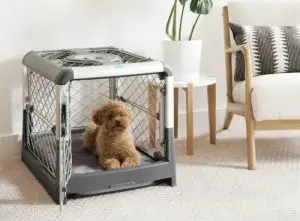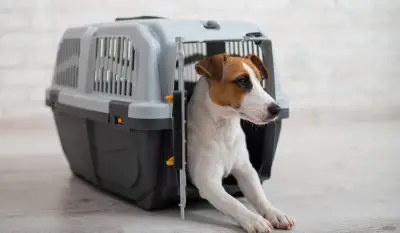Selecting the right crate size for your French Bulldog is pivotal for their comfort and security. The dimensions of the crate play a crucial role in ensuring your furry companion feels safe and relaxed while allowing them ample space to move.
Understanding the ideal French Bulldog crate size involves considering various factors, from their size and behavior to their comfort needs. Let’s delve into the essential considerations when determining the perfect crate size for your French Bulldog.
Ideal crate size for a French Bulldog

When selecting a crate size for a French Bulldog, it’s essential to choose one that provides enough space for comfort and movement but is not excessively large. The crate should be a safe and secure space for your dog.
Here are some general guidelines for choosing the ideal crate size for a French Bulldog:
- Length: Measure your French Bulldog from the tip of their nose to the base of their tail and add 2 to 4 inches. This is the minimum length the crate should be.
- Width: Measure your dog from shoulder to shoulder and add 2 to 4 inches. This is the minimum width the crate should be.
- Height: Measure your French Bulldog from the top of their head to the ground while they are sitting and add 2 to 4 inches. This is the minimum height the crate should be.
Make sure the crate is large enough for your dog to stand up, turn around, and lie down comfortably. It’s important not to choose a crate that is too large, as dogs may feel less secure in a spacious area. A cozy, appropriately sized crate can also aid in housetraining and provide a sense of security for your French Bulldog.
Remember that these are general guidelines, and individual dogs may have different preferences. It’s always a good idea to observe your dog’s behavior in the crate to ensure they are comfortable and feel secure. If you’re unsure about the appropriate size, consult with your veterinarian or a professional dog trainer for personalized advice.
Impact of crate size on comfort
The size of a crate can significantly impact a dog’s comfort and well-being. Here are some considerations regarding the impact of crate size on a dog’s comfort:
- Security and Comfort:
-
- Appropriate Size: A correctly sized crate provides a sense of security and comfort for the dog. It should be large enough for the dog to stand up, turn around, and lie down comfortably, but not so spacious that the dog feels exposed or anxious.
- Den-Like Feel: Dogs are den animals by nature, and a properly sized crate can mimic the den environment, creating a cozy and secure space where they can relax.
- Housetraining:
-
- Right Size for Training: An appropriately sized crate is essential for effective housetraining. Dogs are less likely to eliminate in their sleeping area, so a crate that is too large may not discourage accidents.
- Preventing Anxiety:
-
- Avoiding Isolation Anxiety: A crate that is too large may contribute to feelings of isolation and anxiety. Dogs often feel more secure in a snug space, and a crate that is too big might not provide the same sense of security.
- Travel Comfort:
-
- Safe and Comfortable Travel: When using a crate for travel, it’s important that the crate is properly sized to ensure the dog’s safety and comfort during the journey.
- Health Considerations:
-
- Physical Well-being: For dogs with health issues or recovering from surgery, an appropriately sized crate can aid in their recovery by limiting movement and preventing them from injuring themselves.
- Observation and Monitoring:
-
- Easy Monitoring: A crate that is the right size allows you to monitor your dog easily. You can observe their behavior, notice any signs of distress, and ensure they are safe.
Dimensions for French Bulldog crates
The ideal crate size for a French Bulldog can vary based on the specific dimensions of the individual dog. However, I can provide you with some general guidelines to help you choose an appropriate crate size for a French Bulldog:
- Length: Measure your French Bulldog from the tip of their nose to the base of their tail. Add 2 to 4 inches to that measurement for an appropriate crate length.
- Width: Measure your dog from shoulder to shoulder and add 2 to 4 inches for an appropriate crate width.
- Height: Measure your French Bulldog from the top of their head to the ground while they are sitting. Add 2 to 4 inches for an appropriate crate height.
Remember, the crate should be large enough for your French Bulldog to stand up, turn around, and lie down comfortably. It should not be so large that the dog has excess space that might lead to accidents or make them feel less secure.
As an example, for a typical adult French Bulldog, a crate with dimensions around 24 inches in length, 18 inches in width, and 21 inches in height might be suitable. However, these are just general guidelines, and it’s essential to measure your specific dog to ensure a proper fit.
Always consider the individual needs and preferences of your French Bulldog when selecting a crate, and if you’re unsure, consult with your veterinarian or a professional dog trainer for personalized advice.
Choosing crate size for puppy vs. adult

Choosing the right crate size for a puppy versus an adult dog involves different considerations. Puppies grow rapidly, so it’s important to anticipate their future size while also providing a comfortable space for their current needs.
Here’s a guide for choosing crate sizes for puppies and adult dogs:
Crate Size for a Puppy:
- Anticipate Growth:
-
- Choose a crate that will accommodate the puppy’s adult size. You can estimate this by researching the typical size of the breed or consulting with your veterinarian.
- Adjustable Crates:
-
- Consider using an adjustable crate with a divider panel. This allows you to expand the crate space as the puppy grows. The divider helps maintain a suitable size for housetraining.
- Comfort and Security:
-
- Ensure the crate is not too large for the puppy, as this can hinder effective housetraining. A snug space can provide comfort and a sense of security.
Crate Size for an Adult Dog:
- Measure the Adult Dog:
-
- Measure your dog’s length, width, and height to determine the appropriate crate size. Add a few inches for comfort but avoid going too large.
- Provide Adequate Space:
-
- Choose a crate that allows the adult dog to stand up, turn around, and lie down comfortably. It should be spacious enough for the dog to stretch out, but not excessively large.
- Consider Purpose:
-
- If the crate is for travel or specific activities, such as flying, ensure it meets the size requirements for those purposes.
Transitioning from Puppy to Adult Crate:
- Gradual Transition:
-
- If you start with a smaller crate for a puppy, gradually transition to a larger crate as the dog grows. This ensures they remain comfortable with the confined space.
- Monitor Behavior:
-
- Pay attention to your dog’s behavior in the crate. If they seem cramped or anxious, it might be time to consider a larger crate.
- Comfort and Safety:
-
- Throughout the transition, prioritize your dog’s comfort and safety. The crate should always be a positive and secure space for your pet.
Remember, the crate should be a positive and secure environment for your dog, whether it’s a puppy or an adult. By considering the dog’s size, comfort, and purpose of the crate, you can choose an appropriate size that meets their needs at different life stages.
Factors for selecting crate size

Selecting the right crate size for your dog is crucial for their comfort, well-being, and training. Consider the following factors when choosing a crate size:
- Dog’s Size:
-
- Measure your dog’s length from the tip of the nose to the base of the tail. This measurement, along with the height and width, will help determine the appropriate crate size.
- Adult Size (for Puppies):
-
- If your dog is a puppy, estimate their adult size based on the breed or individual growth patterns. Choose a crate that will accommodate their future size.
- Height when Seated:
-
- Measure your dog’s height when they are sitting. The crate should be tall enough to allow them to sit comfortably without their head touching the top.
- Width and Shoulder Width:
-
- Measure the width of your dog, including the shoulders. The crate should be wide enough to allow them to turn around easily.
- Length for Stretching:
-
- Ensure the crate is long enough for your dog to stretch out comfortably when lying down. Add a few inches to their measured length for an appropriate crate length.
- Divider Panels (for Puppies):
-
- If you have a puppy, consider using a crate with a divider panel. This allows you to adjust the crate size as the puppy grows, making it suitable for housetraining.
- Purpose of the Crate:
-
- Consider the purpose of the crate. Is it for training, travel, or providing a safe space at home? The crate size may vary depending on its use.
- Travel Requirements:
-
- If the crate is for travel, ensure it meets the size requirements of airlines or other transportation regulations. Many travel crates must meet specific size criteria for safety.
- Comfort and Security:
-
- The crate should be a comfortable and secure space for your dog. A crate that is too large may not provide the sense of security that a snugger space can offer.
- Behavioral Observations:
-
- Observe your dog’s behavior in the crate. Signs of stress, anxiety, or discomfort may indicate that the crate is not the right size.
- Consult with Professionals:
-
- If you’re uncertain about the appropriate size, consult with your veterinarian or a professional dog trainer. They can provide guidance based on your dog’s specific needs.
Remember that the crate should be a positive space for your dog, offering security and comfort. Taking the time to measure your dog and consider these factors will help you choose a crate size that promotes your dog’s well-being and positive associations with the crate.
Conclusion
Selecting the right crate size for your French Bulldog is crucial for their well-being and comfort. A crate should be large enough for them to stand, turn, and lie down comfortably, while still providing a sense of security.
Whether it’s a puppy or an adult, consider the dog’s measurements, anticipate growth, and factor in the purpose of the crate. Pay attention to behavioral cues, and if in doubt, consult with professionals for personalized advice.
Choosing the appropriate French Bulldog crate size ensures a positive and secure environment, fostering a healthy relationship between your furry friend and their designated space.


